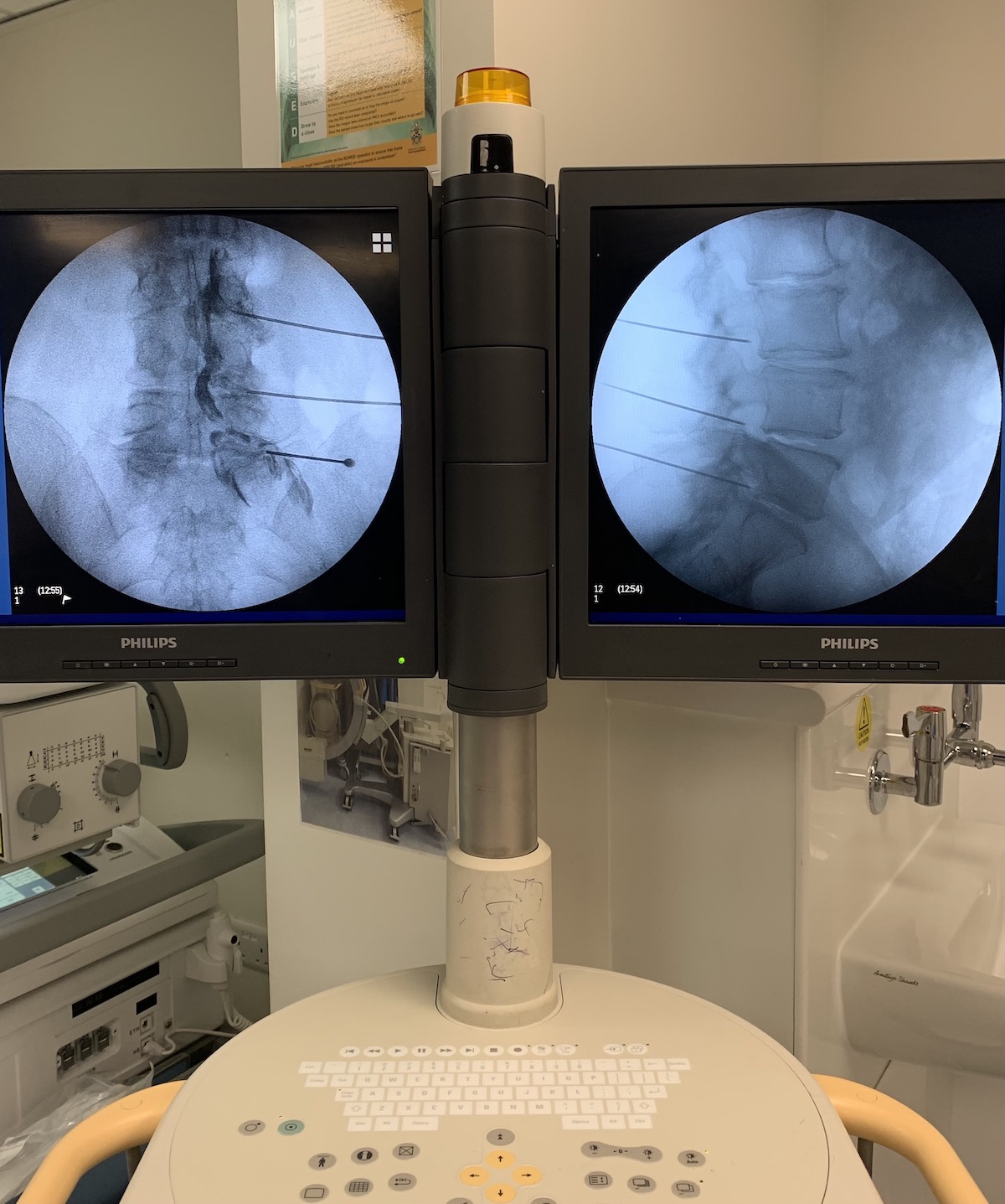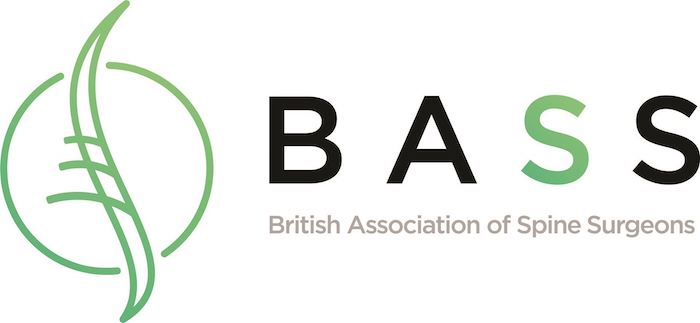Our services: spinal injections
Introduction
There are typically two types of spinal injection procedures performed by Professor Ishaque: nerve root blocks for leg pain and facet joint injections/medial branch blocks for back pain. In both cases, an anti-inflammatory steroid is injected into the spine to calm the inflammation and reduce the pain.
Spinal injections are performed as a day case procedure usually at either BMI Priory or Heath Lodge Clinic under a light general anaesthetic. The specific procedure will be discussed with you once it has been agreed that an injection is required.
Why are spinal injections necessary?
Depending on Professor Ishaque's diagnosis of your condition based on the MRI scan and X-ray results, he may recommend a spinal injection to alleviate your pain symptoms.
How do they work?
Please see the specific pages for how the technique works: nerve root blocks for leg pain and facet joint injections/medial branch blocks. In both cases, an anti-inflammatory steroid is injected into the spine to calm the inflammation and reduce the pain.
What to expect on the day of the injection
On the day of the injection you will need to have been starved (known as 'nil by mouth') from midnight. On admission Professor Ishaque and Dr E J Da Silva (your anaesthetist) will see you in order to go through the consent and talk you through the procedure.
Before the injection, Dr Da Silva will place a small cannula in the back of your hand to allow him to deliver the anaesthetic agents during the procedure. You will then be walked into the theatre itself and shown how to climb onto the operating table in order to get comfortable.
Professor Ishaque will then mark your back with a marker pen using the x-ray machine to guide him regarding the entry point for the spinal injections, and will then clean your back using standard surgical iodine and the procedure is carried out using a sterile technique. You may feel a slight sharp sensation like a pinch which last a few seconds before Dr Da Silva administers the intravenous general anaesthetic which is the local anaesthetic being placed at the needle entry point but often you will already be asleep at this point. You will not feel the actual spinal injection which is much more comfortable and safer for yourself and Professor Ishaque, as he can be sure you will not move at a crucial point during the injection. Please be aware that if you are needle-phobic (very scared of needles) then Professor Da Silva can make sure that you will not even feel this initial injection just under the skin.
Professor Ishaque routinely performs an epidurogram using either Omnipaque or Niopam in order to confirm correct placement of the spinal needle after using x-ray guidance in two planes, taking x-rays from both side to side and from front to back. Once you have had your injection you will be helped back onto your bed and transferred to the recovery suite. As you have had an epidural injection it is standard practice to monitor your blood pressure for about half an hour after the injection.
Following the injections you will be able to eat and drink in order to get your blood sugar levels up and you will be asked to rest for 30 minutes to allow the sensation to return to your legs and the effects of the general anaesthetic to wear off.
You will need to be picked up, as you will not be fit to drive on the day of the injection.
What to expect following a spinal injection
Immediately after the injection it is not unusual to have a slight increase in back pain but often the leg pain is immediately relieved. I would advise you take a few days off after the injection to rest and during this time it is important to keep taking your anti-inflammatory (Diclofenac, Ibuprofen or Naproxen) medication as well as any painkillers.
It is fine to drive the following day but I would limit journeys to less than 40 minutes.
I have had a number of patients who have flown short haul within 1 week of the injection which although is not recommended, is possible provided you keep well hydrated, keep mobile during the flight and wear flight compression stockings bought either online or over the counter at a chemist to reduce the chances of a deep venous thrombosis (DVT) and more importantly a Pulmonary Embolism (PE).
In the weeks immediately following the injection I would advise you to walk regularly as your symptoms allow and to avoid any strenuous exercise and in particular excessive bending, lifting or twisting. Swimming is an ideal exercise as you are supported and if you can’t swim then walking widths in the pool at progressively increasing depth provides increasing resistance helping to build strength and stamina.
In the majority of cases any discomfort associated with the injection should have passed within 2 weeks and the effects of the steroid should be becoming more apparent. I usually advise patients to wait 4 weeks before starting physiotherapy, which will also help with the longer-term recovery.
Simple back pain advice
Bed rest is not recommended. Reduce your activity for the first couple of days. Then, slowly start your usual activities after that. Avoid heavy lifting or twisting of your back for the first six weeks after the pain begins. You should start exercising again after 2-3 weeks.
Be good to your back - follow these tips to reduce your risk of back problems:
Posture
The first thing to remember is posture. Remind yourself to stand up straight, and if you need support when you're sitting or driving, use a lumbar roll (a specialist cushion) to support your lower back. Avoid bending down for routine tasks such as emptying a washing machine. Instead, lower yourself by bending your knees, allowing your spine to keep relatively straight.
Also, 'no pain, no gain' was not a phrase designed for backs. An occasional twinge is one thing but if you find yourself in real, persistent pain don't try to push on through it. If possible keep mobile and seek specialist advice. Back pain associated with arm or leg pain will often benefit from a surgical opinion and any disturbance of bladder or bowel function requires an urgent appointment. If you're lifting things, make sure you know the right technique to keep your spine straight.
Getting your muscles right
Your spine is a bit like the mast on a ship: it's long and tall and depends on the rigging around it to keep it stable. Similarly, our internal 'rigging' (the muscles in our back, abdomen, buttocks and thighs) has the job of holding the spine stable and straight. If they're out of condition, or out of kilter, the forces on your spine are no longer neutralised - and it starts to hurt.
These muscles can be developed through exercises with a physiotherapist, chiropractor or osteopath. Pilates is an excellent alternative. Regular endurance-type exercise us also important, and even a 20-30 minute power walk can have a positive effect.

Spinal injections are not only very effective at relieving leg pain, they are extremely safe - especially when using X-ray guidance and contrast dye to check the needle is in the right place.



